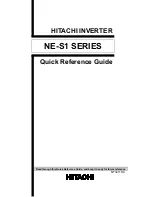
Page 17
©
2017 Sensata Technologies
Installation
2.5 AC
Wiring
This section provides information on how to make the AC connections to the ME inverter using the
correct AC wire size and the corresponding overcurrent protection. Refer to Figures 2-9 through
2-13 for visual overviews of the various AC wiring con
fi
gurations.
2.5.1
Pre-AC Wiring Requirements
CAUTION:
Before installing any AC wiring, review the safety information at the
beginning of this manual and the following to ensure a safe and long-lived system:
• Always use properly rated circuit-breakers. If using an electrical sub-panel, circuit
breakers can only be moved from the main electrical panel to the sub-panel if the
breakers are also listed to be installed in the sub-panel.
• AC wiring must be no less than #12 AWG (3.3 mm
2
) gauge copper wire and be
approved for the application (i.e., RV or marine wiring).
• DO NOT connect the inverter’s output to an AC power source. This could cause
severe damage to the inverter and is not covered under warranty.
• The wire sizes recommended in this manual are based on the ampacities given in
Table 310.17 (in free air) of the National Electrical Code. ANSI/NFPA 70, for 90ºC
(194ºF) copper wire based on an ambient temperature of 30ºC (86ºF).
WARNING:
To reduce the risk of
fi
re, do not connect this inverter to an AC load center
(circuit breaker panel) having multi-wire branch circuits connected.
2.5.2
AC Wire Size and Overcurrent Protection
The AC input and output wiring must be sized per the local electrical safety code requirements
to ensure the wire’s ability to safely handle the inverter’s maximum load current. The AC wiring
must be protected from short circuits and overloads by an overcurrent protection device and have
a means to disconnect the AC circuits. AC overcurrent protection is not included in the inverter
and must be provided as part of the inverter installation. The AC overcurrent protection device
must be a circuit breaker or a fuse/disconnect and be properly sized and branch circuit rated for
the wire it is protecting and the appliances being powered.
Info:
When wiring the AC input and output circuits, we highly recommend a full system
Inverter Bypass Switch
. This simple item provides a convenient way to isolate the
inverter for battery maintenance, and it could save you hours of downtime—if you ever
need to service your inverter—by enabling you to continue to power your AC loads
without any re-wiring.
When the inverter is in Standby mode, the full AC pass-thru capacity of the ME Series inverter/
charger is 30 amps for each AC leg
1
(AC HOT 1 and AC HOT 2). For a 30-amp pass-thru capability,
each AC HOT input to the inverter requires a 30-amp breaker, which corresponds to a minimum wire
size of #12 AWG (in free air). However, the AC HOT 1 and AC HOT 2 may be combined to obtain
a 60-amp pass-thru capability (see Figure 2-10). When tying the AC HOT 1 and HOT 2 together
for a 60-amp pass-thru capability, the AC input to the inverter requires a 60-amp breaker, which
corresponds to a minimum wire size of #8 AWG in conduit. If you are using other circuit breakers/
wire sizes, refer to the appropriate electrical codes for sizing requirements.
CAUTION:
The inverter’s internal AC transfer relay contacts are rated for 30 amps per
leg, the pass-thru current must be no greater than 30 amps per leg or damage to this
relay may occur.
Note
1
– On -15B and -20B models, the pass-thru current is limited by the inverter’s output breaker
size.
















































